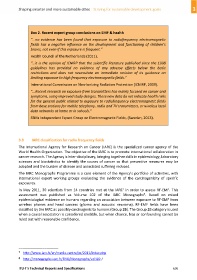Page 615 - Shaping smarter and more sustainable cities - Striving for sustainable development goals
P. 615
Box 2. Recent expert group conclusions on EMF & health
“...no evidence has been found that exposure to radiofrequency electromagnetic
fields has a negative influence on the development and functioning of children’s
brains, not even if this exposure is frequent.”
Health Council of the Netherlands (2011).
“…it is the opinion of ICNIRP that the scientific literature published since the 1998
guidelines has provided no evidence of any adverse effects below the basic
restrictions and does not necessitate an immediate revision of its guidance on
limiting exposure to high frequency electromagnetic fields.”
International Commission on Non‐Ionizing Radiation Protection (ICNIRP, 2009).
“...Recent research on exposure from transmitters has mainly focused on cancer and
symptoms, using improved study designs. These new data do not indicate health risks
for the general public related to exposure to radiofrequency electromagnetic fields
from base stations for mobile telephony, radio and TV transmitters, or wireless local
data networks at home or in schools.”
SSMs Independent Expert Group on Electromagnetic Fields, (Sweden, 2013).
3.3 IARC classification for radio frequency fields
The International Agency for Research on Cancer (IARC) is the specialized cancer agency of the
World Health Organization. The objective of the IARC is to promote international collaboration in
cancer research. The Agency is inter‐disciplinary, bringing together skills in epidemiology, laboratory
sciences and biostatistics to identify the causes of cancer so that preventive measures may be
adopted and the burden of disease and associated suffering reduced.
The IARC Monographs Programme is a core element of the Agency's portfolio of activities, with
international expert working groups evaluating the evidence of the carcinogenicity of specific
exposures.
7
In May 2011, 30 scientists from 14 countries met at the IARC in order to assess RF‐EMF. This
8
assessment was published as Volume 102 of the IARC Monographs . Based on mixed
epidemiological evidence on humans regarding an association between exposure to RF‐EMF from
wireless phones and head cancers (glioma and acoustic neuroma), RF‐EMF fields have been
classified by the IARC as possibly carcinogenic to humans (Group 2B). The Group 2B category is used
when a causal association is considered credible, but when chance, bias or confounding cannot be
ruled out with reasonable confidence.
____________________
7 http://www.iarc.fr/en/media‐centre/pr/2011/index.php
8 http://monographs.iarc.fr/ENG/Monographs/vol102 /
ITU‐T's Technical Reports and Specifications 605

